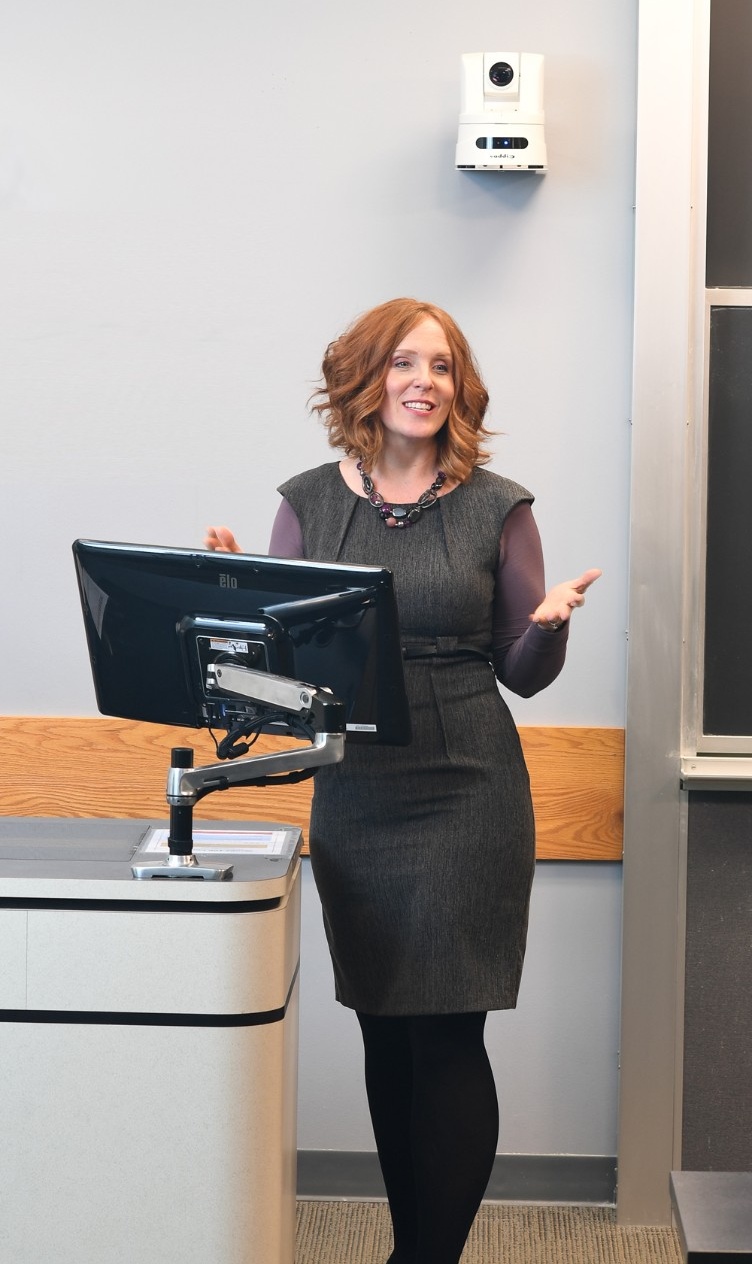The best of both worlds
Hybrid PMBA program offers flexibility and balance for a world-class business education
By Kevin Manne
In the Professional MBA program, students set the pace that fits their lives, with options ranging from 27 months to five years, and can choose from courses that meet on weeknights or Saturdays. Classes start in spring or fall and meet in person once every three weeks, with web-based learning in between.
On a Tuesday evening in October, Chinmay Das leaves his office at Excellus BlueCross BlueShield and heads to the School of Management for one of his Professional MBA (PMBA) classes.

Dianna Cichocki, clinical assistant professor of management science and systems, in the studio where she records videos for students in the hybrid Professional MBA program. Photos: Nancy J. Parisi
Though he’s nine weeks into his first semester, this is just the third time he’s been to campus for his stats class with Professor Dianna Cichocki. That’s because Das is in the first cohort of the recently revised PMBA program, which offers a blend of in-person and web-based learning in a format that improves the quality of the program and enhances the MBA learning experience, while meeting the changing demands of today’s working professionals.
“The hybrid program provides the right balance around my personal life and academic schedule,” he says. “But I still get plenty of face time with my professors—I get the best of both worlds.”
Students in the revised program can choose from courses that meet on weeknights or Saturdays, with one-third of instruction taking place in the classroom and two-thirds technology assisted.
In the classroom, Das learns the dynamics of business through case studies and discussions of real-world corporate examples. During the weeks between, he collaborates with peers using tools such as Zoom and Webex for video conferencing, online meetings and screen sharing, and Flipgrid for collaborative learning and discussion.
“I don’t see any gap when it comes to in-classroom or outside-the-classroom learning—both are fully effective,” he says.
During the day in his role as enterprise architect in emerging technology, Das designs complex IT solutions, and is responsible for recommending technologies that enhance the organization’s capabilities. He says the program is already helping him make better decisions at work.
“I’ve been using what I’ve learned to resolve conflicts, and it’s giving me new directions around my thoughts and ideas,” he says. “It’s also helping me understand the integration of various functions of the organization.”
Courtney Walsh, assistant dean of executive education, says a key advantage of the program is the high-caliber network-building opportunities.
“The hybrid format gives busy professionals time outside traditional class hours to learn and work in groups, and spend in-class time reinforcing and applying what they’ve been studying,” says Walsh. “In many regards, they’ll have more time to interact with faculty and apply the concepts, tools and skills they are learning in the program.”
The School of Management’s part-time MBA program began in 1931 and was transformed into the Professional MBA in 1997.
“These changes are the next step in a continual evolution that keeps our graduates competitive and prepares them for success in today’s global workplace,” adds Walsh.
At left, Katie Andrews, assistant director for recruitment and marketing in the school’s Center for Executive Development, talks with students Harrison Steinwald, Chinmay Das and Chetinai Kalamaphichit.
Harrison Steinwald, financial advisor on the centralized team at M&T Bank, is taking statistics and organizational behavior alongside Das in the first semester of the program. He admits to being a bit hesitant about the hybrid format.
“I didn’t know how organized the virtual weeks would be and I was nervous about falling behind,” Steinwald says. “But the professors are very organized and the weeks are structured so you know exactly what your deliverables are.”
For Steinwald, the biggest benefit of the new format has been the ability to use the time he would’ve spent in a lecture to instead collaborate with group members or complete assignments—tasks that would traditionally be done on weekends or another night of the week.
“Our team can meet during the virtual weeks and work on any group projects, and we can complete our individual work on our own schedule,” he says. “The online lectures are also great because they’re broken up into smaller time slots and you can rewatch them if you’re having trouble grasping a concept.”
Walsh says the ultimate goal of the program is to accelerate and expand students’ careers.
“We now have the ability to offer these benefits in a way that busy professionals can more easily access them,” she says.
To learn more about the PMBA program, visit mgt.buffalo.edu/pmba.
